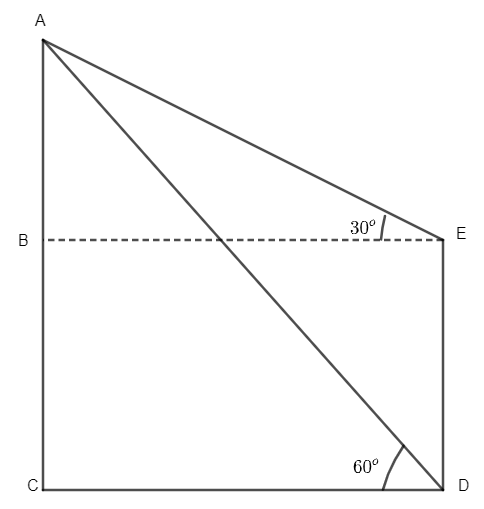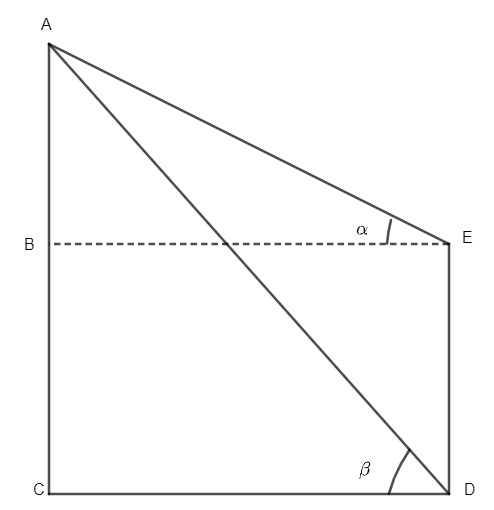
From the second floor of a 100m tall building, the angle of depression of the bottom and top of another building exactly opposite to it are observed to be \[{{60}^{\circ }}\] and \[{{30}^{\circ }}\] respectively. What is the height of the building?
(a) 66m
(b) 67m
(c) 66.67m
(d) 65m
Answer
456k+ views
Hint: We are asked to find the length of the building opposite to the given one. We will first sketch the rough diagram then we will use the trigonometric ratio \[\tan \theta =\dfrac{\text{perpendicular}}{\text{base}},\] where perpendicular is the side in front of \[\theta \] and the base is the side below \[\theta .\] Then we will simplify the acquired value to find the required height.
Complete step by step answer:
We are given that from the second floor of 100m tall building, the angle of depression of bottom and top are \[{{60}^{\circ }}\] and \[{{30}^{\circ }}\] respectively of the opposite building. The point to understand here is from the point of observation both the angles are the angle of depression so this building whose length is to be found is smaller than the first building. So, we will draw our sketch and label as follows.

Here, AC = 100m and let the height of the other building be h m. So, ED = h m as BC = ED. So,
\[BC=hm\]
So, we can see clearly that,
\[AC=AB+BC\]
So, we get,
\[\Rightarrow 100=AB+h\]
\[\Rightarrow AB=100-h\]
Now to find the value of the height of the building, we use trigonometric ratio. In triangle ABE, we have,
\[\tan {{30}^{\circ }}=\dfrac{AB}{BE}\]
Simplifying, we get,
\[\Rightarrow BE=\dfrac{AB}{\tan {{30}^{\circ }}}\]
As, \[\tan {{30}^{\circ }}=\dfrac{1}{\sqrt{3}},\] and AB = 100 – h, so we get,
\[\Rightarrow BE=\dfrac{100-h}{\dfrac{1}{\sqrt{3}}}\]
Simplifying, we get,
\[\Rightarrow BE=\sqrt{3}\left( 100-h \right)m\]
Now, in triangle ACD, we get,
\[\tan {{60}^{\circ }}=\dfrac{AC}{CD}\]
As, AC = 100 and \[\tan {{60}^{\circ }}=\sqrt{3},\] so,
\[\Rightarrow CD=\dfrac{100}{\sqrt{3}}\]
As we can see that CD = BE, so we can compare \[CD=\dfrac{100}{\sqrt{3}}\] and \[BE=\sqrt{3}\left( 100-h \right).\] So,
\[\left( 100-h \right)\sqrt{3}=\dfrac{100}{\sqrt{3}}\]
On simplifying, we get,
\[\Rightarrow \left( 100-h \right)3=100\]
\[\Rightarrow 300-3h=100\]
Solving for h, we get,
\[\Rightarrow h=\dfrac{200}{3}\]
So,
\[\Rightarrow h=66.67m\]
So, the height of the building is 66.67m.
Therefore, option (c) is the right answer.
Note:
Always remember that as we increase the angle, the value of tan keeps on increasing so students shouldn’t be confused. With the value of \[\tan {{30}^{\circ }}\] as \[\sqrt{3}\] the value of \[\tan {{30}^{\circ }}\] is \[\dfrac{1}{\sqrt{3}}\] while the value of \[\tan {{60}^{\circ }}\] is \[\sqrt{3}.\] Also keep track that the angle of depression will keep on increasing as more downward you keep on looking.

So, \[\beta >\alpha \] always.
Complete step by step answer:
We are given that from the second floor of 100m tall building, the angle of depression of bottom and top are \[{{60}^{\circ }}\] and \[{{30}^{\circ }}\] respectively of the opposite building. The point to understand here is from the point of observation both the angles are the angle of depression so this building whose length is to be found is smaller than the first building. So, we will draw our sketch and label as follows.

Here, AC = 100m and let the height of the other building be h m. So, ED = h m as BC = ED. So,
\[BC=hm\]
So, we can see clearly that,
\[AC=AB+BC\]
So, we get,
\[\Rightarrow 100=AB+h\]
\[\Rightarrow AB=100-h\]
Now to find the value of the height of the building, we use trigonometric ratio. In triangle ABE, we have,
\[\tan {{30}^{\circ }}=\dfrac{AB}{BE}\]
Simplifying, we get,
\[\Rightarrow BE=\dfrac{AB}{\tan {{30}^{\circ }}}\]
As, \[\tan {{30}^{\circ }}=\dfrac{1}{\sqrt{3}},\] and AB = 100 – h, so we get,
\[\Rightarrow BE=\dfrac{100-h}{\dfrac{1}{\sqrt{3}}}\]
Simplifying, we get,
\[\Rightarrow BE=\sqrt{3}\left( 100-h \right)m\]
Now, in triangle ACD, we get,
\[\tan {{60}^{\circ }}=\dfrac{AC}{CD}\]
As, AC = 100 and \[\tan {{60}^{\circ }}=\sqrt{3},\] so,
\[\Rightarrow CD=\dfrac{100}{\sqrt{3}}\]
As we can see that CD = BE, so we can compare \[CD=\dfrac{100}{\sqrt{3}}\] and \[BE=\sqrt{3}\left( 100-h \right).\] So,
\[\left( 100-h \right)\sqrt{3}=\dfrac{100}{\sqrt{3}}\]
On simplifying, we get,
\[\Rightarrow \left( 100-h \right)3=100\]
\[\Rightarrow 300-3h=100\]
Solving for h, we get,
\[\Rightarrow h=\dfrac{200}{3}\]
So,
\[\Rightarrow h=66.67m\]
So, the height of the building is 66.67m.
Therefore, option (c) is the right answer.
Note:
Always remember that as we increase the angle, the value of tan keeps on increasing so students shouldn’t be confused. With the value of \[\tan {{30}^{\circ }}\] as \[\sqrt{3}\] the value of \[\tan {{30}^{\circ }}\] is \[\dfrac{1}{\sqrt{3}}\] while the value of \[\tan {{60}^{\circ }}\] is \[\sqrt{3}.\] Also keep track that the angle of depression will keep on increasing as more downward you keep on looking.

So, \[\beta >\alpha \] always.
Recently Updated Pages
What percentage of the area in India is covered by class 10 social science CBSE

The area of a 6m wide road outside a garden in all class 10 maths CBSE

What is the electric flux through a cube of side 1 class 10 physics CBSE

If one root of x2 x k 0 maybe the square of the other class 10 maths CBSE

The radius and height of a cylinder are in the ratio class 10 maths CBSE

An almirah is sold for 5400 Rs after allowing a discount class 10 maths CBSE

Trending doubts
Who was Subhash Chandra Bose Why was he called Net class 10 english CBSE

Write an application to the principal requesting five class 10 english CBSE

What are the public facilities provided by the government? Also explain each facility

What is Commercial Farming ? What are its types ? Explain them with Examples

Complete the sentence with the most appropriate word class 10 english CBSE

Find the area of the minor segment of a circle of radius class 10 maths CBSE




